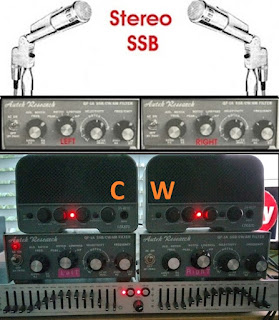The following has been like this for "YEARS" as is evidenced by the referenced dates.
Over the years I have more-or-less figured out the art of SO2-V (Single-OP 2-Vfos);
essentially leveraging the Sub-Rx inside the Yaesu FT-1000mp to run dual-mode (for GiGs
like the 10-meter contest) or running a frequency while S&P'ing (Searching and Pouncing)
on the side. For me, there is no doubt that SO2-V dramatically improved operating efficiency
overall. Then again, it is just as easy for things to become hopelessly confused, turning it into
a completely wasted effort.
For 2022, WQ6X radiosport activities begin with a Yaesu FT-2000 transceiver, relegating
the FT-1000mp to 2ndary status. The eventual goal seemed to be seamlessly integrating the
FT-2000 into the same operating position originally occupied by the older FT-1000mp, which
is then re-positioned to be ready for an actual basic SO2-R operation, later this year.
Performance-wise the FT-2000 features take the original FT-1000mp operations to the next level.
Both transceivers integrate stereo Cw quite well, with the color screens of the 2000, adding to the
visual aesthetic experience. While the K3/0 is a most effective radio setup for running remote operations, nothing compares to the incredibly well laid out ergonomics of the FT-2000.
So why would I want to go to all the trouble (and expense) to create a fully functional SO2-R
setup? If you look at the above stat comparison from the 2025 ARRL DX Cw contest, notice
that MOST of the Top 20 entries (80%) were running SO2-R or 2BISQ (an SO2-R variant).
NX6T ran as a "Multi-2" operation offering two uniquely different remote radio operations.
STN1 unfortunately was plagued by "bubbly" internet resulting in Cw character dropouts.
While your signal may have been quite strong, the dropped characters required numerous
repeats - sorry about that folks.
Time spent running NX6T eliminated the need for separate off-time.
This was fortunate as the final 2 hours brought last-minute openings on 80 and 160 meters.
By 10pm it was all over. For me, there was nothing left to do but COLLAPSE on the bed listening
to Latin Jazz on shortwave using the ICOM 70000 - a GREAT SWL receiver. As quick as the NAQP Cw made the scene, the Cw bands became silent once again - time enough to post the 3830 score and submit a log immediately.
As it turns out, MY solution to this issue is to run SOAB QRP. Rarely, do we see a QRP
operator running some variation of SO2-R, except in this GiG K6JS who took 2nd place.
For me, this certainly is a less expensive and less of a setup hassle approach to making
a high score.
The REAL solution is to give the SO2-R / 2BISQ operators their own "playpen", moving them out
of OUR playpen. Some contests, solve the SO2-R "problem", by instituting a 10-minute band requirement, meaning once a QSO is made on a given band, you are not allowed to make QSOs
on other bands for at least 10-minutes.
What do you think about this?
Are YOU an SO2-R / 2BISQ operator?
Are you OK with only competing against other SO2-R / 2BISQ operators?
Share with us YOUR thoughts on this.





.Jpg)
-3.jpg)
-1.jpg)

.Jpg)









.jpg)



%20Collage.Jpg)



